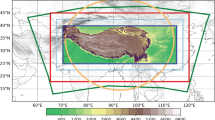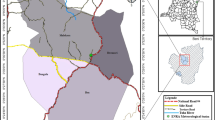Abstract
In this study, surface air temperature from 75 meteorological stations above 3000 m on the Tibetan Plateau are applied for evaluation of the European Centre for Medium-Range Weather Forecasts (ECMWF) third-generation reanalysis product ERA-Interim in the period of 1979–2010. High correlations ranging from 0.973 to 0.999 indicate that ERA-Interim could capture the annual cycle very well. However, an average root-mean-square error (rmse) of 3.7°C for all stations reveals that ERA-Interim could not be applied directly for the individual sites. The biases can be mainly attributed to the altitude differences between ERA-Interim grid points and stations. An elevation correction method based on monthly lapse rates is limited to reduce the bias for all stations. Generally, ERA-Interim captured the Plateau-Wide annual and seasonal climatologies very well. The spatial variance is highly related to the topographic features of the TP. The temperature increases significantly (10°C–15°C) from the western to the eastern Tibetan Plateau for all seasons, in particular during winter and summer. A significant warming trend (0.49°C/decade) is found over the entire Tibetan Plateau using station time series from 1979–2010. ERA-Interim captures the annual warming trend with an increase rate of 0.33°C /decade very well. The observation data and ERA-Interim data both showed the largest warming trends in winter with values of 0.67°C/decade and 0.41°C/decade, respectively. We conclude that in general ERA-Interim captures the temperature trends very well and ERA-Interim is reliable for climate change investigation over the Tibetan Plateau under the premise of cautious interpretation.
Similar content being viewed by others
References
Bao XH, Zhang FQ (2013) Evaluation of NCEP-CFSR, NCEPNCAR, ERA-Interim, and ERA-40 Reanalysis Datasets against Independent Sounding Observations over the Tibetan Plateau. Journal of Climate 26(1): 206–214. DOI: 10.1175/Jcli-D-12-00056.1.
Berrisford P, Dee D, Fielding K, et al. (2009) ERA Report Series: The ERA-Interim archive (version 1.0). European Centre for Medium Range Weather Forecasts. pp 1–16.
Bolstad PV, Swift L, Collins F, et al. (1998) Measured and predicted air temperatures at basin to regional scales in the southern Appalachian mountains. Agricultural and Forest Meteorology 91(3–4): 161–176.
Bosilovich MG, Chen J, Robertson FR, et al. (2008) Evaluation of Global Precipitation in Reanalyses. Journal of Applied Meteorology and Climatology 47(9): 2279–2299. DOI: 10.1175/2008JAMC1921.1.
Decker M, Brunke MA, Wang Z, et al. (2012) Evaluation of the Reanalysis Products from GSFC, NCEP, and ECMWF Using Flux Tower Observations. Journal of Climate 25(6): 1916–1944. DOI: 10.1175/Jcli-D-11-00004.1.
Dee DP, Uppala S (2009) Variational bias correction of satellite radiance data in the ERA-Interim reanalysis. Quarterly Journal of the Royal Meteorological Society 135(644): 1830–1841. DOI: 10.1002/Qj.493.
Dee, DP, Uppala SM, Simmons AJ, et al. (2011) The ERAInterim reanalysis: configuration and performance of the data assimilation system. Quarterly Journal of the Royal Meteorological Society 137(656): 553–597. DOI: 10.1002/Qj.828.
Frauenfeld OW, Zhang TJ, Serreze, MC (2005) Climate change and variability using European Centre for Medium-Range Weather Forecasts reanalysis (ERA-40) temperatures on the Tibetan Plateau. Journal of Geophysical Research-Atmospheres 110(D02101). DOI: 10.1029/2004jd005230.
Gao L, Bernhardt M, Schulz K (2012) Elevation correction of ERA-Interim temperature data in complex terrain. Hydrology and Earth System Sciences 16(12): 4661–4673. DOI: 10.5194/hess-16-4661-2012.
Hu ZY, Zhang C, Hu Q, et al. (2014) Temperature Changes in Central Asia from 1979 to 2011 Based on Multiple Datasets. Journal of Climate 27(3):1143–1167. DOI: 10.1175/Jcli-D-13-00064.1.
Kalnay E, Cai M (2003) Impact of urbanization and land-use change on climate. Nature 423(6939): 528–531. DOI: 10.1038/Nature01675.
Kunkel EK (1989) Simple Procedures for Extrapolation of Humidity Variables in the Mountainous Western United States. Journal of Climate 2(7): 656–669.
Li X, Cheng GD, Lu L (2005) Spatial analysis of air temperature in the Qinghai-Tibet Plateau. Arctic Antarctic and Alpine Research 37(2): 246–252. DOI: 10.1657/1523-0430(2005)037[0246:Saoati]2.0.Co;2.
Liston GE, Elder K (2006) A meteorological distribution system for high-resolution terrestrial modeling (MicroMet). Journal of Hydrometeorology 7(2):217–234.
Liu XD, Chen BD (2000) Climatic warming in the Tibetan Plateau during recent decades. International Journal of Climatology 20(14): 1729–1742. DOI: 10.1002/1097-0088 (20001130)20:14〈1729::Aid-Joc556〉3.0.Co;2-Y.
Liu XD, Cheng ZG, Yan LB, et al. (2009) Elevation dependency of recent and future minimum surface air temperature trends in the Tibetan Plateau and its surroundings. Global and Planetary Change 68(3): 164–174. DOI: 10.1016/j.gloplacha.2009.03.017.
Liu XD, Yin ZY, Shao XM, et al. (2006) Temporal trends and variability of daily maximum and minimum, extreme temperature events, and growing season length over the eastern and central Tibetan Plateau during 1961–2003. Journal of Geophysical Research-Atmospheres 111(D19109). DOI: 10.1029/2005jd006915.
Oku Y, Ishikawa H, Haginoya S, et al. (2006) Recent trends in land surface temperature on the Tibetan Plateau. Journal of Climate 19(12): 2995–3003. DOI: 10.1175/Jcli3811.1.
Pepin NC, Seidel DJ (2005) A global comparison of surface and free-air temperatures at high elevations. Journal of Geophysical Research-Atmospheres 110(D3). DOI: 10.1029/2004jd005174.
Prince SD, Goetz SJ, Dubayah RO, et al. (1998) Inference of surface and air temperature, atmospheric precipitable water and vapor pressure deficit using Advanced Very High-Resolution Radiometer satellite observations: comparison with field observations. Journal of Hydrology 213(1–4): 230–249.
Qiu J (2008) The third pole. Nature 454(7203): 393–396. DOI: 10.1038/454393a.
Rolland C (2003) Spatial and seasonal variations of air temperature lapse rates in Alpine regions. Journal of Climate 16(7): 1032–1046.
Simmons A, Uppala S, Dee D, et al. (2006) ERA-Interim: New ECMWF reanalysis products from 1989 onwards. ECMWF Newsletter 110: 25–35.
Simmons AJ, Willett KM, Jones PD, et al. (2010) Low-frequency variations in surface atmospheric humidity, temperature, and precipitation: Inferences from reanalyses and monthly gridded observational data sets. Journal of Geophysical Research-Atmospheres 115(D01110). DOI: 10.1029/2009JD012442.
Trenberth KE, Koike T, Onogi K (2008) Progress and Prospects for Reanalysis for Weather and Climate. Eos, Transactions American Geophysical Union 89(26): 234–235. DOI: 10.1029/2008EO260002
Uppala S, Dee D, Kobayashi S, et al. (2008) Towards a climate data assimilation system: status updata of ERA-Interim. ECMWF Newsletter 115: 12–18.
Vogt JV, Viau AA, Paquet F (1997) Mapping regional air temperature fields using satellite derived surface skin temperatures. International Journal of Climatology 17(14): 1559–1579.
Wang A, Zeng X (2012) Evaluation of multireanalysis products with in situ observations over the Tibetan Plateau. Journal of Geophysical Research-Atmospheres 117(D05102). DOI: 10.1029/2011jd016553.
Wang J, Yan ZW, Jones PD, et al. (2013) On “observation minus reanalysis” method: A view from multidecadal variability. Journal of Geophysical Research-Atmospheres 118(14): 7450–7458. DOI: 10.1002/Jgrd.50574.
Willmott CJ, Robeson SM, Feddema JJ (1991) Influence of spatially variable instrument networks on climatic averages. Geophysical Research Letters 18(12): 2249–2251.
Xie AH, Ren JW, Qin X, et al. (2009) Feasibility comparison of reanalysis data from NCEP-I and NCEP-II in the Himalayas. Journal of Mountain Science 6(1): 56–65. DOI: 10.1007/s11629-009-0159-7.
Yanai M, Li C (1994) Mechanism of heating and the boundary layer over the Tibetan Plateau. Monthly Weather Review 122: 305–323.
Ye DZ (1981) Some characteristics of the summer circulation over the Qinghai-Xizang (Tibet) Plateau and its neighborhood. Bulletin of the American Meteorological Society 62: 14–19.
Ye DZ, Wu GX (1998) The role of the heat source of the Tibetan Plateau in the general circulation. Meteorology and Atmospheric Physics 67(1–4): 181–198. DOI: 10.1007/Bf01277509.
You QL, Fraedrich K, Ren GY, et al. (2013) Variability of temperature in the Tibetan Plateau based on homogenized surface stations and reanalysis data. International Journal of Climatology 33(6): 1337–1347. DOI: 10.1002/Joc.3512.
You QL, Kang SC, Pepin N, et al. (2010) Relationship between temperature trend magnitude, elevation and mean temperature in the Tibetan Plateau from homogenized surface stations and reanalysis data. Global and Planetary Change 71(1–2): 124–133. DOI: 10.1016/j.gloplacha.2010.01.020.
Author information
Authors and Affiliations
Corresponding author
Rights and permissions
About this article
Cite this article
Gao, L., Hao, L. & Chen, Xw. Evaluation of ERA-interim monthly temperature data over the Tibetan Plateau. J. Mt. Sci. 11, 1154–1168 (2014). https://doi.org/10.1007/s11629-014-3013-5
Received:
Accepted:
Published:
Issue Date:
DOI: https://doi.org/10.1007/s11629-014-3013-5




